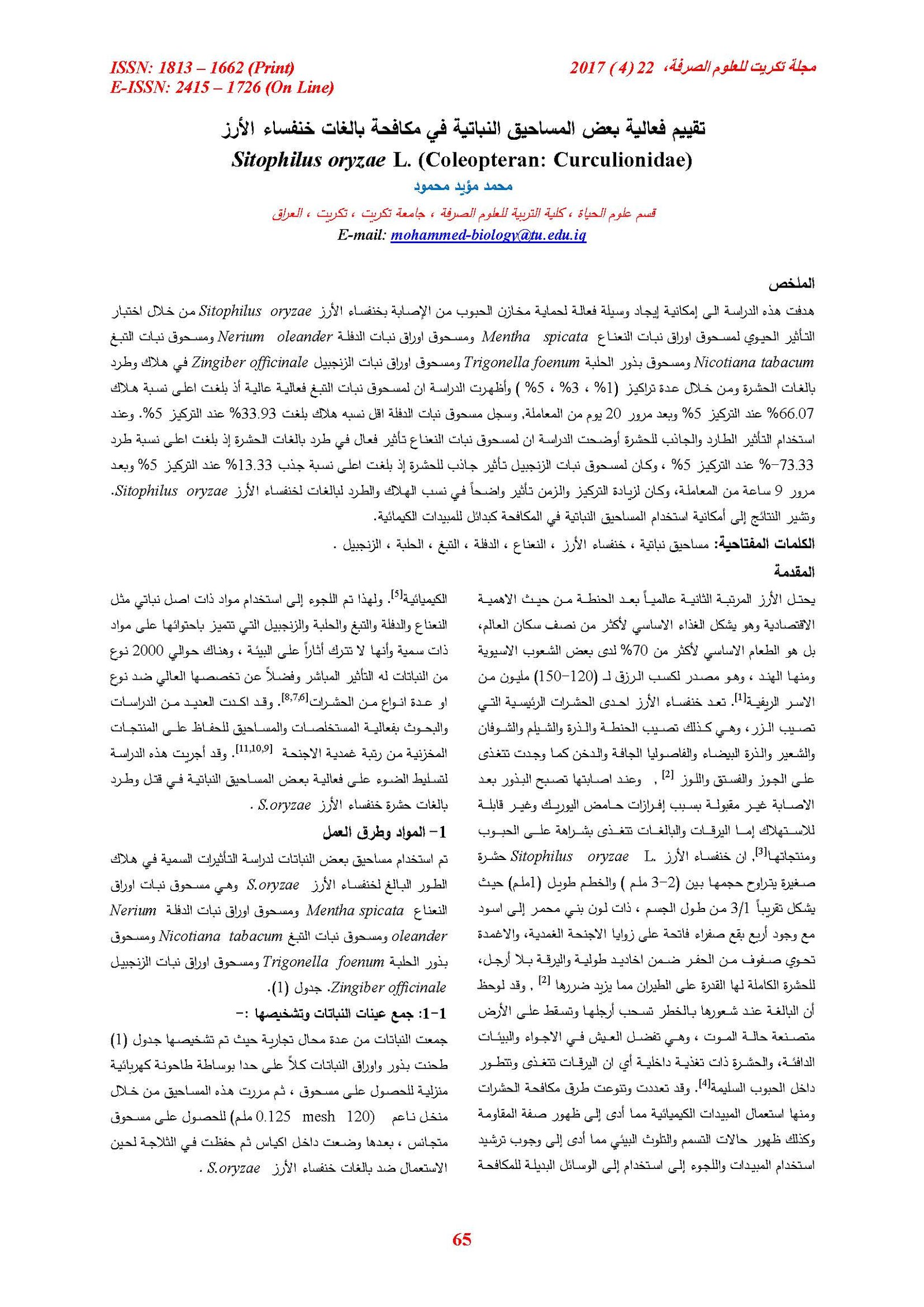Assess the effectiveness of some plant powders in the fight against adult Sitophilus oryzae L. (Coleoptera: Curculionidae)
Main Article Content
Abstract
This study aimed to the possibility of finding an effective device to protect grain storehouses from the infection by the Sitophilus oryzae through testing the vital influence of mint leaves powder Mentha spicata, Nerium oleander, Nicotiana tabacum, Zingiber officinale, and seed powder Trigonella foenum. in exterminating and repellent the insect through many concentration (1%, 3%, 5% ). The results revealed that the N.tabacum leaves powder has a high effectiveness , and the highest extermination rate reached 66.07% at a concentration of 5%. And after 20 days of treatment the N.oleander leaves powder reached its lowest rate of extermination 33.93% at a concentration of 5%. And with using of the insect attractant and repellent effect the study revealed that M.spicata leaves powder has an effective repellent influence, and its highest repellent rate reached -73.33% at a concentration of 5% and after 9 hours of treatment it revealed that Z.officinale powder had an insect attractant effect and its lowest attractant rate reached 13.33% at a concentration of 5%. This increasing of time and concentration had an explicit influence on the S.oryzae repellent and extermination rates. And the results indicate the possibility of using the botanical powder in the controlling, as an alternatives of chemical insecticides
Article Details

This work is licensed under a Creative Commons Attribution 4.0 International License.
Tikrit Journal of Pure Science is licensed under the Creative Commons Attribution 4.0 International License, which allows users to copy, create extracts, abstracts, and new works from the article, alter and revise the article, and make commercial use of the article (including reuse and/or resale of the article by commercial entities), provided the user gives appropriate credit (with a link to the formal publication through the relevant DOI), provides a link to the license, indicates if changes were made, and the licensor is not represented as endorsing the use made of the work. The authors hold the copyright for their published work on the Tikrit J. Pure Sci. website, while Tikrit J. Pure Sci. is responsible for appreciate citation of their work, which is released under CC-BY-4.0, enabling the unrestricted use, distribution, and reproduction of an article in any medium, provided that the original work is properly cited.
References
1- Govindan, K. and S. Jeyarajan Nelson. (2009). Insecticidal activity of twenty plants powders no mortality, adult emergence of Sitophilus oryzae L. and grain weight loss in paddy J of Biopesticides, 2: 2.pp169 – 172.
2- Koehler, P. G. (2012). Identification characteristic of Rice Weevlis.ENY261 Univ. of Florida.
4- Viglianco, A.; R. Novo; C. Coliniragn; M. Nassetta and E. Cavallo (2008). Plant extracts
antifeedant and repellent effects of extracts of three plants from Córdoba (Argentina) Against Sitophilus oryzae (L.) (Coleoptera: Curculionidae).
6- AL-Sharook, Z. M. & Balan, Y. J. and Remold, H. (1991). Insecte growth inhibitiors from tow tropical Meliaceae effect of crude extracts on mosquito larvae, J. Appl. Ent. 111:pp.425-430.
7- Klocke J.A (1989). Plant compounds as source and models of insectcontrol agents. In: Hostettmann, K. (Ed.), Economic and Medicinal Plant Research . Academic Press, London, pp. 103-144.
8- Oyedunmade, E.E.A., (1998). Control of nematode pests of cowpea with Mocap (Ethoprop), leaf residues of neem (Azadirachta indica, rattle weed (Crotalaria retusa) and nitta (Hyptis suaveolens. Centrepoint Science Edition, 8(1):pp 57-63.
9- Keita,S.,S. B.A. Umoek and J.G. Smith,(2006). The insecticidal activity of petroleum ether extract of Hyptis suaveolens Poit. (Labiatae) seeds on Plutella xylostella (L.) Lepidoptera: Y Ponomeutidae). Agricultural Journal, 1(1): pp11-13.
10- Lambert, J.D.H., J. Gale, J.T. Arnason and B.J. Philogene, (1985). Bruchid control with traditionally used insecticidal plants, Hyptis spicigera and Cassia nigricans. Journal of Insect and Application, 6(2):pp 167-170.
11- Musa, A.K., M.C. Dike, C.I. Amatobi and I. Onu, (2007). Evaluation of methanolic extracts of selected of Trogoderma granarium Everts (Coleoptera: Journal of Agricultural Research and Policies, 2(3):pp 91-95.
12- EL-Lakwah, F.; R. Mohamed; and A. Abde-Aziz.(2000) Toxicity and Joint Action of Cumin Seeds Extract with certain Controlled Atmospheres against Stored Product Insects. Fumigation in Stored Products, Fresno, CA. 29 Oct. - 3 Nov., Executive Printing Services, Clovis, CA, U.S.A. pp133-147.
13- Suiter, R.; Michael, D. and Lisa, M. (2012).Stored Product Pests in the Home
http://www.caes.uga.edu/topics/disasters/drought/.2012.
15- Abbott, W. S (1925).A method of computing the effectiveness of an insecticide. J. Econ. Entomol. 18 (2 ): pp265-267.
16- Busvine , J.R., Common wealth Agric (1971) . Bureau , p.345.
18- Muhammad S. Kazan A. Mansoor H. Abdul R. Umair S and Abid A. (2013). Repellent and Toxicological Impact of Acetone Extracts of Nicotiana tabacum, Pegnum hermala, Saussurea costus and Salsola baryosma against Red Flour Beetle, Tribolium castaneum (Herbst). Pakistan J. Zool., vol. 45(6), pp. 1735-1739.
20- AL-Jaber, A.)2006 .Toxicity and repellency of seven plant essential oils to oryzaephilus surinamensis (Coleopera:siluanidae) and Tribolium castanium (Coleoptera:tenebriodae). scientific journal of king faisat university (Basic and Applied science ). 7 (1),pp 49-59.
23- Epidi.T.T and Odili. E.O.(2009). Biocidal activity of selected plant powders against Tribolium castaneum Herbst in stored groundnut (Arachis hypogea L.) African Journal of environmental science and technology Vol.3(1).pp001-005.
26- Halawah, Z. A. ; Mohamed, R. A. and El – Kashlan, I. H. (1998). Labrotatory evolution of some plants and inseticides against beetle Callosobruchus maculatus infesting stored product. Egypt. J. Agr. Res. 76 (1):pp 85 – 93.
27- Tolez, A.,J.Zygdlo, G.Cueto and M. Piocollo. (2006). Fumigant and repellent properties of essential oil and compound agonist permethrin resistant Pediculus humans (Aoplara Pediculidae) from Argentina. Journal of medical entomology 43(5): pp888-895.
32- Moore, S., Aleglet and N. Hill (2002). Insect repellent (plant based insect repellents) CRC. Press. London .pp225.
